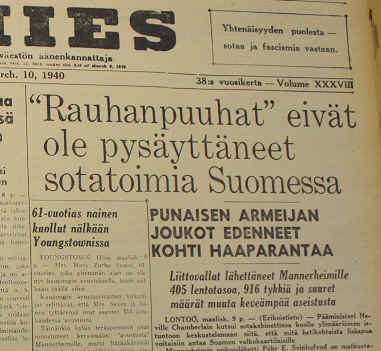|
| |
Cutting Finland in Half
Finland’s only land contact to Western Europe is north of the Gulf of Bothnia
with Sweden. The coastal town Oulu is on the narrowest point between the Soviet border and
the sea. Cutting Finland in half became a major war goal for the Soviets. Finland’s
only land contact to the free world and aid was through Sweden. By cutting Finland in half
by Oulu, the Soviets would have isolated Finland. The communist press made up Soviet
successes to fit the propaganda illustrating the might of the Red Army. On their way to
Oulu, the Soviets sent their 163rd and 44th divisions in from Raate and Juntusranta
toward Suomussalmi. As the war was a surprise to the Finns, there were only a few border
guards present, so the Soviets advanced the 24 miles from the border to Suomussalmi with
little resistance. By the time they reached Suomussalmi, Finnish troops were alerted, and
the Soviet advance was halted.
The Soviet troops did not know how to ski, so they were forced to stay on the roads. There
they became targets for the Finns that skied in from both sides of the road and put a
couple of machine guns in positions to cut off the road every few miles. The Soviets were
trapped on the road. The battle plan on how to fight the Soviets was drawn up by Captain
Alpo Marttinen, who later became a colonel in the US Army. See page 126.
The Finns destroyed two Soviet divisions in the area around Suomussalmi. Robert
Edwards’ book White Death estimates that of the two divisions with 35,000 soviet
soldiers, 30,000 perished. The first division eliminated was the Soviet 163rd. While the
world press reported on this Soviet defeat on January first and second, Työmies first
page headline January 3rd read: "The Red Army has accelerated its attack on all
fronts."
The second division destroyed, the Soviet 44th division, was from the Ukraine and thus
totally out of its element in the north. The division used gun oil that froze solid at
-15°F, making some of their weapons inoperable when the temperatures fell to -20°F.155
Pictures of abandoned tanks, trucks, cannon etc., were printed in the world press.
Finland’s war booty from the operation included 58 tanks, 100 artillery pieces, 12
armored cars, and 520 trucks.
A Russian documentary puts the number killed at 13,000-23,000.156 Before being
destroyed, the Soviet divisions had traveled 24 miles into Finland. Though the Finns took
back every inch the Soviet’s had advanced, the communist newspapers continued to
report steady success on the attempt to cut Finland in two.
The Daily Worker headline on Dec. 13, 1939, was "RED ARMY CUTS INTO CENTRAL FINLAND
Take Town 56 miles from Soviet Frontier. Soviet troops have battled half way across the
roadless central front of Finland toward the key town of Oulu." The following day,
the paper’s headline read, "Red Army Drives 65 Miles Into Finland."
On December 17, the Daily Worker showed a map suggesting that Soviet troops were
approaching the village of Vaala, which is 85 miles from the Russian border and 51 miles
from the target city Oulu. The fictitious advance continued and, as reported on December
26, "The Red Army has Resumed its advance in Finland toward the Finnish Seaport of
Oulu."
The communist press was quiet about the cutting of Finland in two for a while, but on
March 10, Työmies’ headline was, "RED ARMY TROOPS HAVE ADVANCED TOWARD
HAAPARANTA." The town of Haaparanta (in Swedish, "Haparanda") is a border
town in Sweden, northwest of Oulu, separated from Finland by the Tornio River. It is
located on the top of the Gulf of Bothnia.

|
Työmies March 10, 1940.
The paper was concerned that peace would break out before Finland was vanquished, so the
paper proclaims in glee: "Peacemongers have not stopped war operations in
Finland."
Return to menu page
Takaisin
Tillbaka till första sidan
|